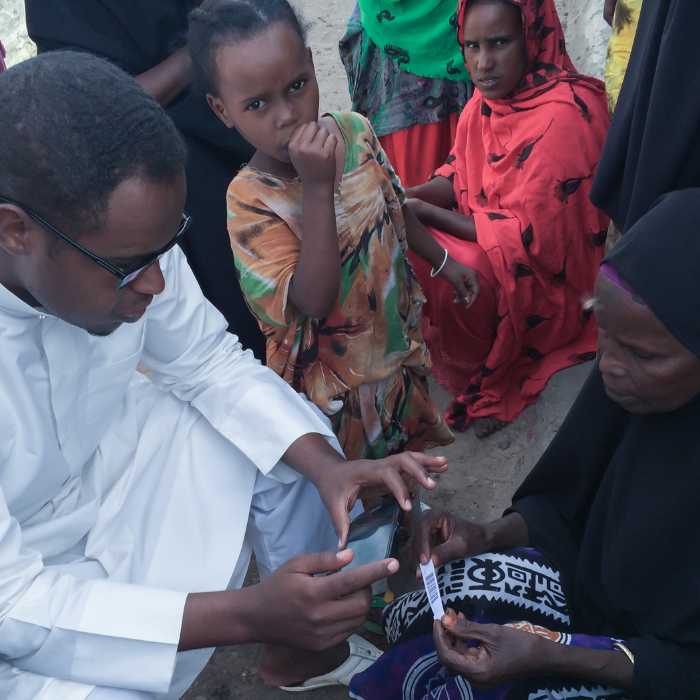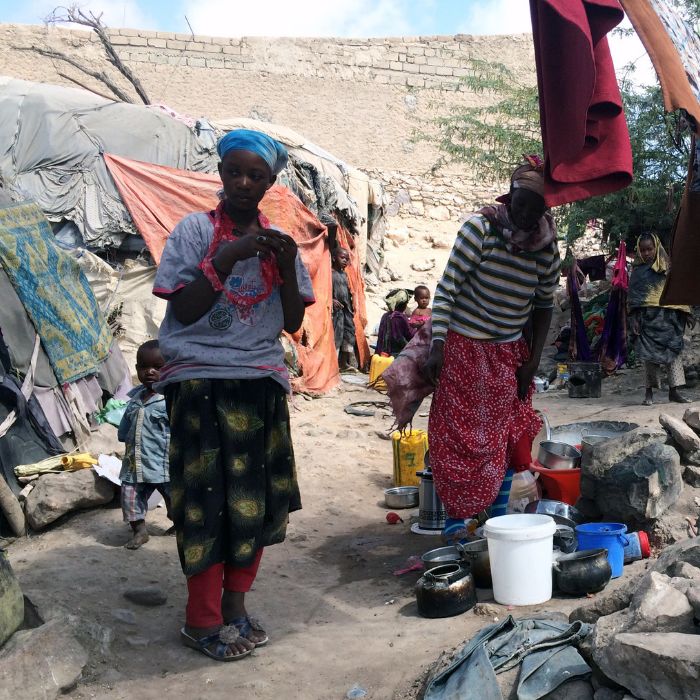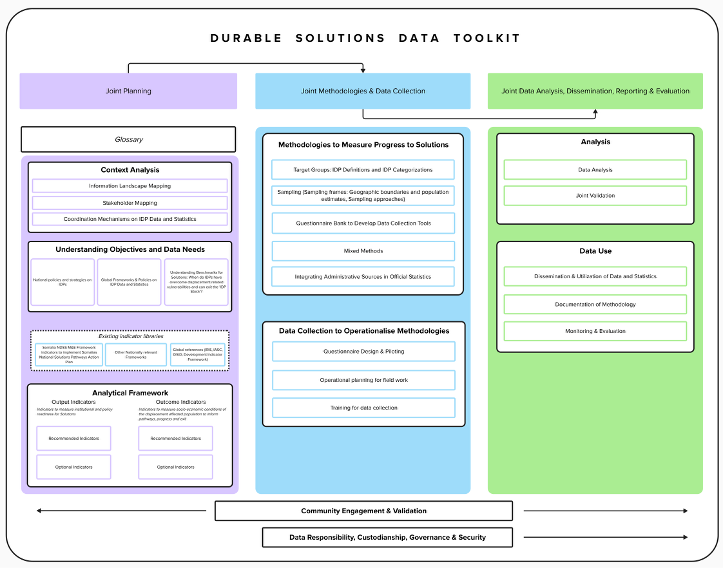Somalia experiences one of the world’s most complex protracted displacement situations, fueled by armed conflict and the impact of climate change-induced droughts and floods. The country now has an estimated four million internally displaced persons (IDPs), with a significant trend in IDPs fleeing rural areas towards IDP settlements in urban areas. Humanitarian response in Somalia drives the production of data on internal displacement, coordinated through the humanitarian cluster system. Efforts primarily concentrate on estimating IDPs in the country to guide aid provision. To tackle displacement challenges, the Federal Government of Somalia (FGS) has issued a National Durable Solutions Strategy (NDSS) in 2020 and a National Solutions Pathways Action Plan in 2024.
JIPS’ involvement in Somalia began in 2013 when various UN, NGO and government partners asked us to support urban profiling exercises in Mogadishu and Hargeisa. Since then, JIPS has continued to engage with in-country partners and provide support, such as to map the in-country data ecosystem and opportunities and gaps for the operationalisation of the NDSS. Between 2021 and 2023, JIPS led on behalf of the Expert Group on Refugee, IDP and Statelessness Statistics (EGRISS) the technical support to the Federal Government of Somalia to mainstream IDPs in national statistics in line with the International Recommendations on IDP Statistics.
Since 2024, JIPS has been supporting government actors alongside national and international organisations in the implementation of the UN Secretary-General’s Action Agenda on Internal Displacement, specifically to improve coordination with humanitarian and development stakeholders on data for solutions. The 2-year project, made possible through the Internal Displacement Solutions Fund (IDSF), aims to advance an IDP statistical framework to monitor the implementation of the government’s national policies on durable solutions.
Profiling for durable solutions in Mogadishu (2013 – 2016)
In Mogadishu, the profiling process focused on the hundreds of informal settlements in which IDPs are known to live. The purpose was to update the overall figure of persons living in these settlements, analyse their displacement history and based on IASC Framework on Durable Solutions for IDPs examine the families’ skills, capacities, specific needs and coping mechanisms that affect their decision-making for the future, with the aim of establishing a mutually agreed evidence base to inform a comprehensive strategy and related programming.
The profiling exercise had significant impact: the results later contributed to the inclusion of IDPs in Somalia’s National Development Plan. They furthermore provided the much-needed baseline for the more recent 5-year Durable Solutions Strategy of the Banaadir Regional Administration (BRA).
Key outputs:
Our support spanned all phases of the profiling process, from facilitating the definition of the exercise scope and objectives to supporting the design of the methodology and tools for data collection, to analysis, validation, and final reporting and dissemination. Our support also involved the mapping of the in-country information landscape on internal displacement, to ensure relevant secondary data and key data gaps were considered. Finally, it included the enhancement of local capacities for profiling to ensure that local partners were able to carry out similar exercises in other parts of the country.

The profiling exercises took place in two significantly distinct urban contexts – Mogadishu and Hargeisa –, but in both a collaborative durable solutions analysis had an important impact. The profiling exercise in Mogadishu led to the Government incorporating durable solutions to internal displacement into the national development plan. In addition, actors working in Mogadishu agreed that a specific strategy should be developed for addressing protracted displacement in the city. The profiling also ensured that these undertakings were informed by a solid agreed-upon evidence base rather than assumptions and outdated and fragmented information.
According to Mohamed Moalim, then Head of the National Statistics Directorate at the Ministry of Planning: “The Mogadishu profiling results and recommendations have been used by the ministry in the formation of policy and analysis, and were a great springboard to discuss including a durable solutions chapter in the national development plan.”
The sense of local ownership of the exercise played a significant role in these achievements, and in the setting up of the Somalia IDP Durable Solutions Initiative, a UN-led project to leverage political willingness and humanitarian and development support to develop a comprehensive durable solutions strategy. The profiling process also prompted dialogue with development stakeholders, who came to recognise displacement as an impoverishment factor and understand the importance of municipalities’ role in implementing durable solutions. It also opened the door for fundraising across the humanitarian and development sectors, and the creation of a taskforce led by the Mayor of Mogadishu to develop the city’s Urban Durable Solutions Strategy.
According to Khadra Elmi, profiling advisor: “The collaborative commitment and tailored methodology resulted in data that was accepted and used by the Somali government and humanitarian community. An analysis that started to bridge humanitarian and development concerns and foster the policy dialogue to unlock obstacles to durable solutions.”
According to Nina Schrepfer, Somalia Protection Cluster Coordinator: “The profiling data bears a considerable degree of legitimacy due to the collaborative nature of the process from planning to data collection and validation of the analysis that brought together the municipality, federal government institutions, NGOs and UN partners.”
The Mogadishu exercise also confirmed the importance of designing a flexible methodology able to adapt to emerging challenges, and of adopting an area-based approach that establishes a better understanding of the specific characteristics of different population groups together with the broader urban system.
Profiling for durable solutions in Hargeisa (2013-2016)
In Hargeisa, the profiling aimed to inform a new way of responding to the displacement situation in the city with a pressing need to support durable solutions in collaboration with the authorities, NGOs and UN partners. The exercise focused on the capital of the Somaliland region, where according to estimates thousands of IDPs had arrived over the past years, sharing the informal settlements with labour migrants, refugee returnees, asylum seekers and local urban poor.
In addition, the project had a specific focus on IDPs from South Central Somalia, a “hidden population’ who often lived outside of the known settlement areas and were therefore suspected to be particularly vulnerable due to limited access to assistance and protection.
Key outputs:
JIPS supported the exercise throughout, including to establish a profiling taskforce, map areas with IDP settlements, design the methodology, conduct a quality assurance check on the data collected remotely, deliver on-site training on data cleaning and analysis, as well as support more complex analysis and formulation of key findings in the profiling report.

Implemented at the same time as the Mogadishu exercise, the profiling in Hargeisa changed the overall understanding of displacement in the city substantially by providing evidence about the situations of different population groups in one comparative analysis. It revealed that the different population groups share many of the same challenges, which should primarily be addressed through inclusive long-term development planning and interventions rather than humanitarian assistance.
Nina Schrepfer, Somalia Protection Cluster Coordinator said: “The profiling in Hargeisa allowed to demystify who is an IDP and who is an urban poor. It demonstrated that their needs were very even and hence more of an urban development challenge than a humanitarian one.”
Khadra Elmi, profiling advisor, stressed the importance of the collaborative nature of profiling: “This exercise makes me realise the importance of genuine and invested high-level buy-in from all stakeholders, in particular local authorities, in order for the data to have impact.”
The exercise also showed the extent to which community information campaigns and participation can help to overcome the challenges associated with reaching additional vulnerable populations such as refugees and asylum seekers.
Developing the National Statistics Sectoral Strategic Plan for improved IDP statistics (2021-2023)
The Somalia National Bureau of Statistics (SNBS) has set up a plan for the inclusion of IDPs in national statistics in line with the International Recommendations on IDP Statistics (IRIS). Following a request for technical support from the Expert Group on Refugee, IDP and Statelessness Statistics (EGRISS) in May 2021, JIPS on behalf of EGRISS has been supporting the SNBS to develop a standalone IDP Statistics Sectoral Plan to be included in the update of the National Strategy for the Development of Statistics. Finalised in February 2023, the plan’s objective is to strengthen the capacity of the Bureau, enhance coordination, and establish a system for the inclusion of IDPs in official data sources.
In the process of preparing the plan, from January to July 2022, JIPS conducted an information mapping of potential IDP data sources from state agencies, international actors, and multi-stakeholder groups to feed into the production of national statistics.
The preliminary results and insights from this research were further discussed at a technical in-person meeting that was organized by JIPS on 1-2 August 2022 in Nairobi, Kenya. The meeting, which brought together representatives from regional and country teams of international actors working in Somalia, the SNBS and the EGRISS Secretariat, generated a shared understanding of the IRIS and of the existing data ecosystem on Internal Displacement in Somalia. It also fostered a discussion on how the international community can best support government-owned statistics on the phenomenon.
By invitation from MoPIEd, JIPS and the SNBS also presented the work on the IDP Strategic Statistics Sectoral Plan at the High-Level National Durable Solutions Conference, held in Mogadishu on 27-28 February 2023. Subsequent bilateral meetings with SNBS, NCRI, UNHCR, UNDP, the Integrated Office of the DSRSG/RC/HC (RCO), and the then-initiated Steering Group on Solutions to Internal Displacement, served to discuss how ongoing efforts for official statistics on IDPs and Durable Solutions can be linked, with support from JIPS.
Key outputs this far:
—
JIPS’ national-level support in Somalia in 2021-2023 was made possible through the generous co-funding and multi-donor partnership with the Danish International Development Agency (DANIDA), the USAID’s Bureau for Humanitarian Assistance (BHA), the European Commission’s Directorate-General for European Civil Protection and Humanitarian Aid Operations (ECHO), and the Norwegian Ministry of Foreign Affairs (NFMA).
The technical meeting that took place in August 2022 marks a first milestone achievement in the ongoing process of EGRISS’ support, led by JIPS, to the Government of Somalia for the improvement of IDP statistics. The High-Level National Durable Solutions Conference in February 2023 represents another critical step forward, not only with the presentation of the finalised and agreed-upon IDP Strategic Statistics Sectoral Plan, but also by ‘connecting the dots’ between IDP official statistics and Data for Solutions, in line with the related national strategy, Solutions coordination structure, and implementation of the Action Agenda.
Key recommendations from JIPS’ workshop in Nairobi, August 2022
Key takeaways from JIPS’ mission, February 2023
Enhancing coordination on measuring progress towards durable solutions (2023-ongoing)
As a priority country for implementing the UN Secretary-General’s Action Agenda on Internal Displacement, the Federal Government of Somalia, in collaboration with the UN Resident and Humanitarian Coordinator’s Office (RCO), committed in 2023 to guiding one million IDPs towards durable solutions. Following JIPS’ participation in a High-Level National Durable Solutions Conference in February 2023, a collective effort was proposed to discuss a standardised approach for measuring durable solutions at scale.
Following the completion of JIPS’ support to the Somalia National Bureau of Statistics (SNBS) in developing a standalone IDP Strategic Statistics Sectoral Plan (2021-2023), the SNBS sent a new request to JIPS for technical and capacity building support in April 2023. The request focuses on building consensus with government and international actors around the concepts and definition of an IDP for producing official statistics in Somalia, enhancing collaborative platforms to measure solutions to displacement, and including IDPs in large-scale annual surveys to better measure progress towards durable solution.
On 25-26 October 2023, JIPS co-organized a workshop in Mogadishu, bringing together 40 data experts from government institutions, UN agencies, and international non-governmental organisations in Somalia to discuss a common approach to measuring progress towards durable solutions to internal displacement.
Prior to the workshop, JIPS collaborated with RCO, IOM, MoPIED, UNHCR and ReDSS to map approaches for identifying IDPs and capturing durable solutions indicators in data collection exercises in Somalia, aligning with the Data for Solutions component of the Action Agenda and promoting the implementation of the IRIS.
Key outputs:
—
JIPS’ support in Somalia in 2023 was made possible through the generous co-funding and multi-donor partnership with the European Commission’s Directorate-General for European Civil Protection and Humanitarian Aid Operations (ECHO), the Danish International Development Agency (DANIDA), and USAID’s Bureau for Humanitarian Assistance (BHA).
The workshop presented a crucial opportunity for a technical discussion to produce recommendations for a standardised, collective approach for Data for Solutions in Somalia, based on existing frameworks and good practices. Discussions included connecting the IRIS with the monitoring and evaluation (M&E) framework of the NDSS, addressing diverse data needs, and establishing a common understanding of the division of labour between various data systems producing information on IDPs and their distinct objectives. Recommendations from the workshop emphasised the need for government leadership and accountability in implementing standards for IDP data collection in Somalia.
Reflections from the joint workshop in Mogadishu, November 2023
Fundamental to moving forward is standardisation of key concepts and methodological approaches, which will allow for triangulation across the diverse data systems. Priority elements include:
Joint Government-UN project on Data for Solutions (IDSF; 2024-ongoing)
Launched in 2023, the project Asaaska Fikir (“Basis of Thought”) aims to accelerate durable solutions in Somalia by scaling up sustainable and nationally owned pathways for people-centered and area-based durable solutions for displacement-affected communities (DAC). The project is funded by the Internal Displacement Solutions Fund (IDSF) and contributes to the implementation of the UN Secretary-General’s Action Agenda on Internal Displacement. It is implemented by UN agencies (IOM, UNHCR, RCO, UNDP, UN-Habitat) in collaboration with the Centre for Rural Development and Durable Solutions (formerly Poverty Reduction and Durable Solutions Directorate).
On behalf of UNDP Somalia, JIPS is supporting the data component of the project. More specifically, JIPS is leading the technical multi-stakeholder effort to develop two key components:
Both of these elements draw on extensive multi-stakeholder engagement and consultations with 37 actors from line ministries, state representatives of the Ministry of Planning and commissions for refugees and IDPs, UN agencies, and INGOs. The original idea for the data toolkit emerged at the JIPS-facilitated workshop in Mogadishu in October 2023. During a workshop facilitated by JIPS in October 2024 as part of this project, the Federal Government of Somalia also launched a Data for Solutions Subworking Group under the broader existing Durable Solutions Technical Working Group (DSTWG), which also ensure regular progress reviews of the toolkit and capacity building framework.
Both the data toolkit and capacity development framework are planned to be finalised and validated by late Summer 2025. A second project phase (2025-26; pending confirmation) will focus on delivering training to government staff to strengthen their technical capacities to coordinate data for solutions in line with the toolkit and monitor progress.

Government:
Centre for Rural Development and Durable Solutions; Ministry of Planning, Investment and Economic Development (MoPIED); Somalia National Bureau of Statistics (SNBS); National Commission for Refugees and IDPs (NCRI); Somali Disaster Management Agency (SoDMA); Ministry of Labour and Social Affairs (MoLSA); Ministry of Interior, Federal Affairs and Reconciliation (MoIFAR); Banadir Regional Administration; and other Federal Members States (FMA).
International Community:
UN Resident and Humanitarian Coordinator’s Office (RCO); International Organization for Migration (IOM); Regional Durable Solutions Secretariat (ReDSS); UN Development Programme (UNDP); UN Refugee Agency (UNHCR); Danish Refugee Council (DRC); and IMPACT Initiatives.
—
JIPS’ support in Somalia since 2024 has been made possible through the generous co-funding and multi-donor partnership with the European Commission’s Directorate-General for European Civil Protection and Humanitarian Aid Operations (ECHO), the Danish International Development Agency (DANIDA), the Internal Displacement Solutions Fund (IDSF), and USAID’s Bureau for Humanitarian Assistance (BHA).
A foundation for a common understanding of displacement in Somalia
The toolkit is being developed through a highly participatory process involving multiple stakeholders. Their active participation throughout the process, while at times demanding, is essential to ensure coherence in, and sustainable outcomes from, ‘data for solutions’ in support of Somalia’s Federal Government’s needs and priorities, across diverse government entities and international supporting actors, including the UN. As such, beyond providing technical and statistical guidance, the toolkit is also contributing to broader outcomes for a shared understanding of the internal displacement situation in-country and longer-term solutions.
IDP identification and IDP markers
During the workshop in October ’24, participants repeatedly highlighted the persistent issue of diverging practice for identifying IDPs in data collection (including administrative data) in Somalia. They emphasised the need for a common technical approach for defining the IDP populations and relevant sub-groups in data efforts, in line with the established legal definition of an IDP. The project activities supported by JIPS will mark a milestone achievement in this context.
Targeted capacity strengthening
The various consultations and workshops surfaced the need to strengthen capacities on ‘data for solutions’ at different levels and with different key audiences in Somalia. The forthcoming capacity development framework integrates this aspect by targeting, in an initial step, members of the Data for Solutions Technical Working Group and across the following two levels: